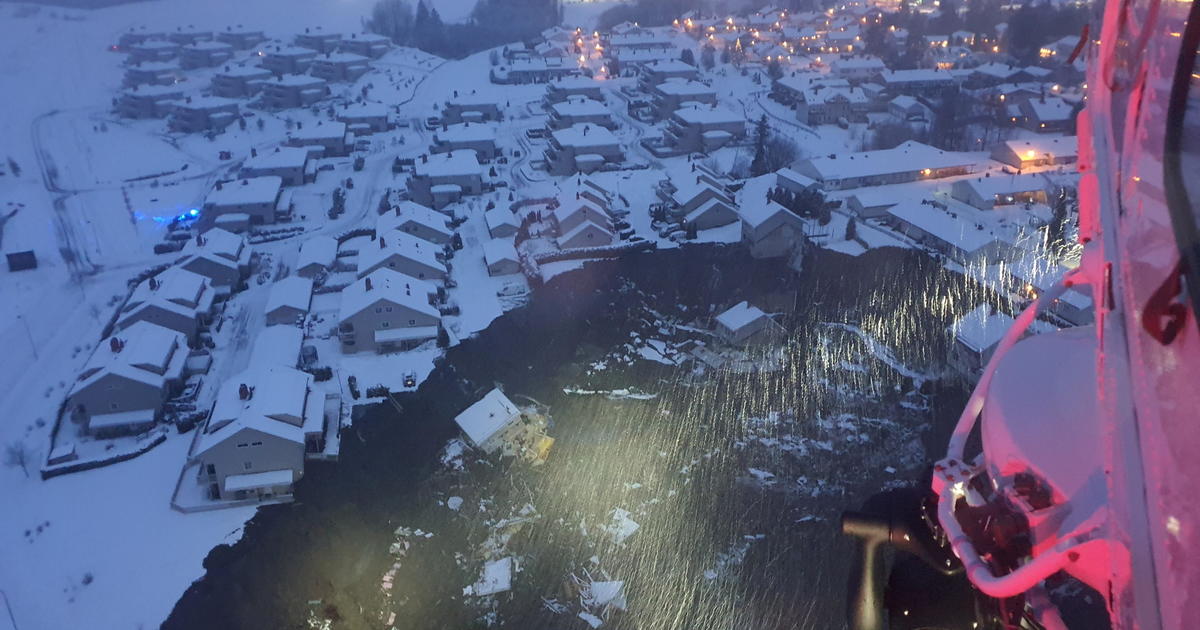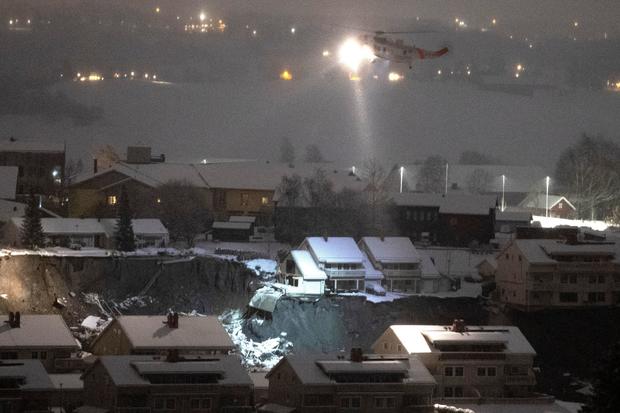
Rescuers used helicopters, drones and dogs on Thursday to scan unstable terrain the day after a large landslide destroyed houses in a village near the Norwegian capital Oslo. At least ten people had not yet been identified and ten more injured, local officials said.
On Wednesday night a whole slope collapsed in Ask, in the municipality of Gjerdrum, 15 miles northeast of the capital. The houses were crushed and buried in dense, dark mud that was still too shaky on Thursday for rescuers to access on foot, Reuters news agency reported.
THIRD BENDIKSBY / NTB / AFP / Getty
Temperatures below freezing and snowfall made efforts to strengthen the remaining structures and make it even harder for the missing, with some houses left on the edge of the crater created by the slide. Several buildings collapsed on Wednesday.
Norwegian Prime Minister Erna Solberg, who traveled to the village of about 1,000 people on Wednesday, described the landslide as “one of the largest” the country has ever seen.
“It’s a dramatic experience to be here,” Solberg told reporters, expressing special concern for those still missing.
“The situation is so unstable with the mud that it is still not possible to do anything other than helicopter rescues,” he added.
NTB SCANPIX via Reuters
Norwegian media said 700 people had been evacuated from their homes and the municipality warned that up to 1,500 could have to leave the region for security reasons.
“We are still looking for survivors,” Roger Pettersen, head of the site’s police operation, told Reuters, adding that children and adults were among the missing.
Police said 10 people were injured, and one was taken to Oslo with serious injuries.
Pettersen said Wednesday that emergency calls had arrived from people saying all their homes were moving with them inside. Night helicopters used heat scanning technology to search for people and reduced several rescuers to the structures as part of their efforts.
“There are dramatic reports and the situation is serious,” Pettersen said.
According to the Norwegian Directorate of Water Resources and Energy (NVE), what happened was a so-called “fast clay slide” of approximately 328 to 766 yards.
“This is the biggest landslide in recent times in Norway, given the number of houses involved and the number of evacuees,” NVE spokeswoman Laila Hoivik told AFP.
Fast clay is a type of clay found in Norway and Sweden that can collapse and become fluid when it is protruding.
“The area has been studied previously and is known to contain fast clay. The possibility of large similar slides in the area is low at the moment,” Hoivik said.
Reuters quoted Norwegian broadcaster TV2 as saying that a 2005 geological study had detected clay and considered the area unsuitable for residential development, but that new houses were built on the ground just a couple of years ago. years later.
The King of Norway, Harald, said in a rare public statement that the accident “made a deep impression on him”.
“My thoughts are on all those affected, the injured, those who have lost their homes and are now living in fear and uncertainty of the extent of the disaster,” he said.

